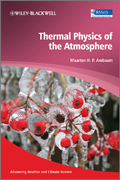
Thermal Physics of the Atmosphere offers a concise and thorough introduction on how basic thermodynamics naturally leads on to advanced topics in atmospheric physics. The book starts by covering the basics of thermodynamics and its applications in atmospheric science. The later chapters describe major applications, specific to more specialized areas of atmospheric physics, including vertical structure and stability, cloud formation, and radiative processes. The book concludes with a discussion of non-equilibrium thermodynamics as applied to the atmosphere. This book provides a thorough introduction and invaluable grounding for specialised literature on the subject. Introduces a wide range of areas associated with atmospheric physics. Starts from basic level thermal physics. Ideally suited for readers with a general physics background. Self-assessment questions included for each chapter. Supplementary website to accompany the book. INDICE: Preface. 1 Ideal gases. 1.1 Thermodynamic variables. 1.2 Microscopic viewpoint. 1.3 Ideal gas mixtures. Problems. 2 The first and second laws. 2.1 Work. 2.2 Energy conservation: the first law. 2.3 Entropy and the second law. 2.4 Boltzmann entropy. 2.5 Entropy and probability: a macroscopic example. 2.6 Entropy and probability: a stochastic example. Problems. 3 General applications. 3.1 Thermodynamic potentials. 3.2 Heat capacity. 3.3 Properties of ideal gases. 3.4 Van der Waals’ Gases. 3.5 Open systems: enthalpy flux. 3.6 Latentheat. 3.7 Turbulent energy fluxes. 3.8 Potential temperature. Problems. 4 Theatmosphere under gravity. 4.1 Geopotential. 4.2 Hydrostatic balance. 4.3 Adiabatic lapse rate. 4.4 Buoyancy. 4.5 Dry static energy and Bernoulli function. 4.6 Statistical mechanics. Problems. 5 Water in the atmosphere. 5.1 The Clausius Clapeyron equation. 5.2 Calculation of saturated vapour pressure. 5.3 Humidity variables. 5.4 Moist static energy. Problems. 6 Vertical structure of the moist atmosphere. 6.1 Adiabatic lapse rate for moist air. 6.2 Entropy budget for saturated air. 6.3 Finite amplitude instabilities. 6.4 Vertical structure in thermodynamic diagrams. 6.5 Convective available potential energy. 7 Cloud drops. 7.1 Homogeneous nucleation: the Kelvin effect. 7.2 Heterogeneous nucleation: the Raoult effect. 7.3 Kohler theory. 7.4 Charge-enhanced nucleation. 7.5Droplet growth. Problems. 8 Mixtures and solutions. 8.1 Chemical potentials. 8.2 Ideal gas mixtures and ideal solutions. 8.3 Raoult’s law revisited. 8.4 Boiling and freezing of solutions. Problems. 9 Thermal radiation. 9.1 Thermal radiation and Kirchhoff’s law. 9.2 The Stefan Boltzmann and Wien displacement laws. 9.3 Global energy budget and the greenhouse effect. 9.4 Horizontal variations. 9.5 Radiative intensity. 9.6 Radiative transfer. 9.7 Radiative-convectiveequilibrium. 9.8 Thermodynamics of a photon gas. 9.9 Derivation of the Plancklaw. Problems. 10 Non-equilibrium processes. 10.1 Energetics of motion. 10.2 Diabatic effects and the second law. 10.3 Thermodynamics of forced dissipativesystems. 10.4 Climate thermodynamics. Problems. A Functions of several variables. B Exergy and thermodynamic stability. C Thermodynamic diagrams. D Relationship between energy density and energy flux.
- ISBN: 978-0-470-74515-1
- Editorial: John Wiley & Sons
- Encuadernacion: Cartoné
- Páginas: 256
- Fecha Publicación: 06/04/2010
- Nº Volúmenes: 1
- Idioma: Inglés
